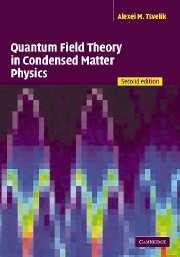Book contents
- Frontmatter
- Contents
- Preface to the first edition
- Preface to the second edition
- Acknowledgements for the first edition
- Acknowledgements for the second edition
- I Introduction to methods
- II Fermions
- III Strongly fluctuating spin systems
- IV Physics in the world of one spatial dimension
- Introduction
- 22 Model of the free bosonic massless scalar field
- 23 Relevant and irrelevant fields
- 24 Kosterlitz–Thouless transition
- 25 Conformal symmetry
- 26 Virasoro algebra
- 27 Differential equations for the correlation functions
- 28 Ising model
- 29 One-dimensional spinless fermions: Tomonaga–Luttinger liquid
- 30 One-dimensional fermions with spin: spin-charge separation
- 31 Kac–Moody algebras: Wess–Zumino–Novikov–Witten model
- 32 Wess–Zumino–Novikov–Witten model in the Lagrangian form: non-Abelian bosonization
- 33 Semiclassical approach to Wess–Zumino–Novikov–Witten models
- 34 Integrable models: dynamical mass generation
- 35 A comparative study of dynamical mass generation in one and three dimensions
- 36 One-dimensional spin liquids: spin ladder and spin S = 1 Heisenberg chain
- 37 Kondo chain
- 38 Gauge fixing in non-Abelian theories: (1 + 1)-dimensional quantum chromodynamics
- Select bibliography
- Index
36 - One-dimensional spin liquids: spin ladder and spin S = 1 Heisenberg chain
Published online by Cambridge University Press: 05 May 2010
- Frontmatter
- Contents
- Preface to the first edition
- Preface to the second edition
- Acknowledgements for the first edition
- Acknowledgements for the second edition
- I Introduction to methods
- II Fermions
- III Strongly fluctuating spin systems
- IV Physics in the world of one spatial dimension
- Introduction
- 22 Model of the free bosonic massless scalar field
- 23 Relevant and irrelevant fields
- 24 Kosterlitz–Thouless transition
- 25 Conformal symmetry
- 26 Virasoro algebra
- 27 Differential equations for the correlation functions
- 28 Ising model
- 29 One-dimensional spinless fermions: Tomonaga–Luttinger liquid
- 30 One-dimensional fermions with spin: spin-charge separation
- 31 Kac–Moody algebras: Wess–Zumino–Novikov–Witten model
- 32 Wess–Zumino–Novikov–Witten model in the Lagrangian form: non-Abelian bosonization
- 33 Semiclassical approach to Wess–Zumino–Novikov–Witten models
- 34 Integrable models: dynamical mass generation
- 35 A comparative study of dynamical mass generation in one and three dimensions
- 36 One-dimensional spin liquids: spin ladder and spin S = 1 Heisenberg chain
- 37 Kondo chain
- 38 Gauge fixing in non-Abelian theories: (1 + 1)-dimensional quantum chromodynamics
- Select bibliography
- Index
Summary
The spin S = 1 Heisenberg chain is an interesting object. First of all, as we have already discussed in Part III, spin chains with integer and half-integer spins have very different low energy properties. The results of Chapter 16 suggest that chains with integer spin have a spectral gap which is generated dynamically. The fact that there are many experimental realizations of quasi-one-dimensional antiferromagnets with S = 1 makes the situation even more interesting. The most well studied compound is Ni(C2H8N2)2NO2(ClO4), abbreviated as NENP. Localized spins belong to magnetic Ni ions and all the other ingredients are necessary just to arrange them into well separated chains. The experiments show that there is indeed a spectral gap (Aijro et al., 1989; Renard et al., 1987; see Fig. 36.1). This gap is not very small in comparison with the bandwidth, but one can still hope that the continuum description is good enough. The Monte Carlo simulations give for the spin S = 1 Heisenberg chain the ratio of the correlation length to the lattice spacing ξ/a = 6.2 (Nomura, 1989) which can still be treated as a large number.
There is another intriguing fact about the S =1 Heisenberg chain which makes it attractive for a theorist. It is the presence of a hidden, so-called topological order. This feature puts this theory in a much broader context of spin liquids, magnetically disordered systems with a hidden order.
Spin ladder
The spin S = 1 Heisenberg chain can be described as a limiting case of two ferromagnetically coupled S = 1/2 chains. The problem of coupled chains (so-called spin ladders) is interesting in its own right.
- Type
- Chapter
- Information
- Quantum Field Theory in Condensed Matter Physics , pp. 334 - 349Publisher: Cambridge University PressPrint publication year: 2003



